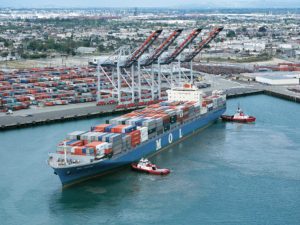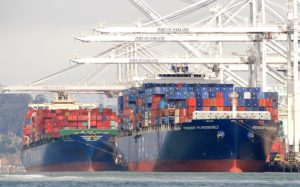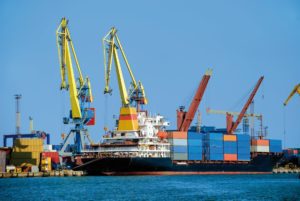
Nika-Tera sea terminal (Nika-Tera specialized seaport, Mykolaiv), part of Group DF belonging to Dmytro Firtash, in July 2019 handled 790,000 tonnes of cargo, which is two times more than in the same period of 2018, the company reported on its website.
According to the report, the major volume of cargo turnover at Nika-Tera accounted for grain and leguminous cargoes (73%), bulk cargoes ranked second (27%).
In July, the terminal handled 37 vessels transshipping and that was the highest indicator of this month since the beginning of the work of the terminal.
As reported, Nika-Tera handled 335 vessels transshipping, 5.84 million tonnes of freights in 2018, which is 40% more than in 2017.
Nika-Tera is a highly mechanized marine terminal, part of Group DF’s port business. The terminal includes four specialized complexes: grain, for transshipment of fertilizers, bulk freight, and liquid cargo.

The seaports of Ukraine in January-April 2019 handled 48.8 million tonnes of cargo, which is 5 million tonnes, or 12% more compared to the same period of 2018.
According to the Ukrainian Sea Ports Authority, most of all, the positive dynamics of increase in transshipment was influenced by exports, which during the reporting period grew by 20% compared to the same period last year, whereas imports and transit decreased by 5% and 18.5% respectively.
Grain handling grew by almost one-third or 4.4 million tonnes compared to January-April 2018, to 18 million tonnes. Transshipment of ore rose by more than a quarter, to more than 10.5 million tonnes.
The growth trend in container handling is also kept: in the first four months of 2019, compared to the same period of 2018, Ukrainian seaports transshipped 47,800 TEU more (18.6% up).

The seaports of Ukraine in January-April 2019 handled 48.8 million tonnes of cargo, which is 5 million tonnes, or 12% more compared to the same period of 2018.
According to the Ukrainian Sea Ports Authority, most of all, the positive dynamics of increase in transshipment was influenced by exports, which during the reporting period grew by 20% compared to the same period last year, whereas imports and transit decreased by 5% and 18.5% respectively.
Grain handling grew by almost one-third or 4.4 million tonnes compared to January-April 2018, to 18 million tonnes. Transshipment of ore rose by more than a quarter, to more than 10.5 million tonnes.
The growth trend in container handling is also kept: in the first four months of 2019, compared to the same period of 2018, Ukrainian seaports transshipped 47,800 TEU more (18.6% up).

Yuzhny seaport (Odesa region), the largest seaport of Ukraine in terms of transshipment, increased cargo transshipment by 18.7% in January-March 2019 compared to January-March 2018, to 11.6 million tonnes.
According to the Ukrainian Sea Ports Authority, during this period the port increased the handling of exported cargo by 39.8%, to 8.973 million tonnes, decreased the handling of imported cargo by 31.98%, to 1.203 million tonnes, transit cargo handling fell by 10.22%, to 1.422 million tonnes, and the port increased handling of coastal freight 2.86-fold, to 31,930 tonnes.
According to the types of cargo, the port in January-March 2019 increased the transshipment of liquid cargo by 9.13%, to 1.077 million tonnes, increased the transshipment of dry bulk cargo by 19.45%, to 9.207 million tonnes, and increased the transshipment of packaged goods by 22.16%, to 1.315 million tonnes.
Container handling amounted to 52,000 TEU (a more than threefold increase).
Yuzhny port was founded in 1978. It is located on the Adzhalyk firth and is the deepest harbor in Ukraine. The length of its berths is around 2.6 kilometers.

Yuzhny seaport (Odesa region), the largest seaport of Ukraine in terms of transshipment, increased cargo transshipment by 18.7% in January-March 2019 compared to January-March 2018, to 11.6 million tonnes.
According to the Ukrainian Sea Ports Authority, during this period the port increased the handling of exported cargo by 39.8%, to 8.973 million tonnes, decreased the handling of imported cargo by 31.98%, to 1.203 million tonnes, transit cargo handling fell by 10.22%, to 1.422 million tonnes, and the port increased handling of coastal freight 2.86-fold, to 31,930 tonnes.
According to the types of cargo, the port in January-March 2019 increased the transshipment of liquid cargo by 9.13%, to 1.077 million tonnes, increased the transshipment of dry bulk cargo by 19.45%, to 9.207 million tonnes, and increased the transshipment of packaged goods by 22.16%, to 1.315 million tonnes.
Container handling amounted to 52,000 TEU (a more than threefold increase).
Yuzhny port was founded in 1978. It is located on the Adzhalyk firth and is the deepest harbor in Ukraine. The length of its berths is around 2.6 kilometers.

Nika-Tera sea terminal (Nika-Tera specialized seaport, Mykolaiv), part of Group DF belonging to Dmytro Firtash, in January-February 2019 handled more than one million tonnes of cargo, which is 56.7% more than in the same period of 2018, the press service of the company has reported.
According to the company, as of February 27, 2019, Nika-Tera port had handled more than one million tonnes of cargo, significantly exceeding the dynamics of last year’s transshipment: in January-February 2018 the port’s cargo turnover amounted to 638,000 tonnes, while the figure of the first million was reached only at the end of March.
“Nika-Tera port continues to master new technologies for receiving and transshipment of goods. Thus, in February 2019 the first train of railway platforms with specialized containers for bulk cargo transportation entered the port. In total, a batch consisting of 88 containers with corn was processed on 44 platforms with a total weight of more than 2,000 tonnes,” the press service of the port said.
To implement the new cargo handling scheme, containers were unloaded from railway platforms to container trucks inside the port.